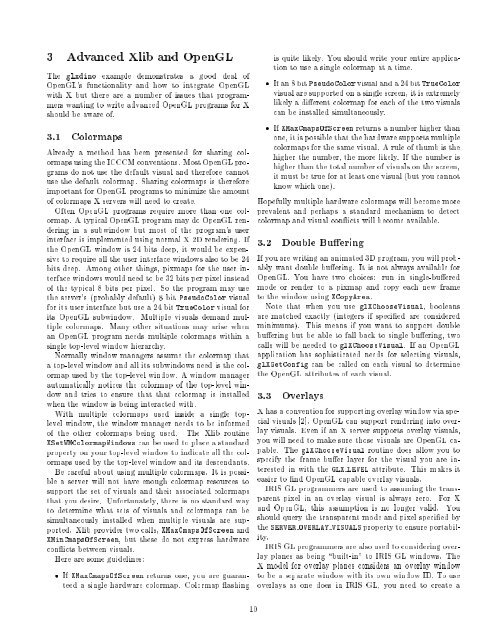OpenGLTM and X, Part 2: Using OpenGL with Xlib
OpenGLTM and X, Part 2: Using OpenGL with Xlib
OpenGLTM and X, Part 2: Using OpenGL with Xlib
You also want an ePaper? Increase the reach of your titles
YUMPU automatically turns print PDFs into web optimized ePapers that Google loves.
Ad anc d lib <strong>and</strong> n<br />
The glxdino example demonstrates a good deal of<br />
<strong>OpenGL</strong>'s functionality <strong>and</strong> how to integrate <strong>OpenGL</strong><br />
<strong>with</strong> X but there are a number of issues that programmers<br />
wanting to write advanced <strong>OpenGL</strong> programs for X<br />
should be aware of.<br />
.<br />
Already a method has been presented for sharing colormaps<br />
using the ICCCM conventions. Most <strong>OpenGL</strong> programs<br />
do not use the default visual <strong>and</strong> therefore cannot<br />
use the default colormap. Sharing colormaps is therefore<br />
important for <strong>OpenGL</strong> programs to minimize the amount<br />
of colormaps X servers will need to create.<br />
Often <strong>OpenGL</strong> programs require more than one colormap.<br />
A typical <strong>OpenGL</strong> program may do <strong>OpenGL</strong> rendering<br />
in a subwindow but most of the program's user<br />
interface is implemented using normal X 2D rendering. If<br />
the <strong>OpenGL</strong> window is 2 bits deep, it would be expensive<br />
to require all the user interface windows also to be 2<br />
bits deep. Among other things, pixmaps for the user interface<br />
windows would need to be 32 bits per pixel instead<br />
of the typical 8 bits per pixel. So the program may use<br />
the server's (probably default) 8 bit seudo olor visual<br />
for its user interface but use a 2 bit rue olor visual for<br />
its <strong>OpenGL</strong> subwindow. Multiple visuals dem<strong>and</strong> multiple<br />
colormaps. Many other situations may arise when<br />
an <strong>OpenGL</strong> program needs multiple colormaps <strong>with</strong>in a<br />
single top-level window hierarchy.<br />
ormally window managers assume the colormap that<br />
a top-level window <strong>and</strong> all its subwindows need is the colormap<br />
used by the top-level window. A window manager<br />
automatically notices the colormap of the top-level window<br />
<strong>and</strong> tries to ensure that that colormap is installed<br />
when the window is being interacted <strong>with</strong>.<br />
With multiple colormaps used inside a single toplevel<br />
window, the window manager needs to be informed<br />
of the other colormaps being used. The <strong>Xlib</strong> routine<br />
et olormap indo s can be used to place a st<strong>and</strong>ard<br />
property on your top-level window to indicate all the colormaps<br />
used by the top-level window <strong>and</strong> its descendants.<br />
Be careful about using multiple colormaps. It is possible<br />
a server will not have enough colormap resources to<br />
support the set of visuals <strong>and</strong> their associated colormaps<br />
that you desire. nfortunately, there is no st<strong>and</strong>ard way<br />
to determine what sets of visuals <strong>and</strong> colormaps can be<br />
simultaneously installed when multiple visuals are supported.<br />
<strong>Xlib</strong> provides two calls, ax maps creen <strong>and</strong><br />
in maps creen, but these do not express hardware<br />
conicts between visuals.<br />
Here are some guidelines:<br />
If ax maps creen returns one, you are guaranteed<br />
a single hardware colormap. Colormap ashing<br />
is quite likely. ou should write your entire application<br />
to use a single colormap at a time.<br />
If an 8 bit seudo olor visual <strong>and</strong> a 2 bit rue olor<br />
visual are supported on a single screen, it is extremely<br />
likely a dierent colormap for each of the two visuals<br />
can be installed simultaneously.<br />
If ax maps creen returns a number higher than<br />
one, it is possible that the hardware supports multiple<br />
colormaps for the same visual. A rule of thumb is the<br />
higher the number, the more likely. If the number is<br />
higher than the total number of visuals on the screen,<br />
it must be true for at least one visual (but you cannot<br />
know which one).<br />
Hopefully multiple hardware colormaps will become more<br />
prevalent <strong>and</strong> perhaps a st<strong>and</strong>ard mechanism to detect<br />
colormap <strong>and</strong> visual conicts will become available.<br />
.<br />
If you are writing an animated 3D program, you will probably<br />
want double buering. It is not always available for<br />
<strong>OpenGL</strong>. ou have two choices: run in single-buered<br />
mode or render to a pixmap <strong>and</strong> copy each new frame<br />
to the window using opy rea.<br />
ote that when you use gl oose isual, booleans<br />
are matched exactly (integers if specied are considered<br />
minimums). This means if you want to support double<br />
buering but be able to fall back to single buering, two<br />
calls will be needed to gl oose isual. If an <strong>OpenGL</strong><br />
application has sophisticated needs for selecting visuals,<br />
gl et on ig can be called on each visual to determine<br />
the <strong>OpenGL</strong> attributes of each visual.<br />
.<br />
X has a convention for supporting overlay window via special<br />
visuals 2 . <strong>OpenGL</strong> can support rendering into overlay<br />
visuals. Even if an X server supports overlay visuals,<br />
you will need to make sure those visuals are <strong>OpenGL</strong> capable.<br />
The gl oose isual routine does allow you to<br />
specify the frame buer layer for the visual you are interested<br />
in <strong>with</strong> the<br />
attribute. This makes it<br />
easier to nd <strong>OpenGL</strong> capable overlay visuals.<br />
IRIS GL programmers are used to assuming the transparent<br />
pixel in an overlay visual is always zero. For X<br />
<strong>and</strong> <strong>OpenGL</strong>, this assumption is no longer valid. ou<br />
should query the transparent mode <strong>and</strong> pixel specied by<br />
the<br />
property to ensure portability.<br />
IRIS GL programmers are also used to considering overlay<br />
planes as being built-in to IRIS GL windows. The<br />
X model for overlay planes considers an overlay window<br />
to be a separate window <strong>with</strong> its own window ID. To use<br />
overlays as one does in IRIS GL, you need to create a<br />
10
















